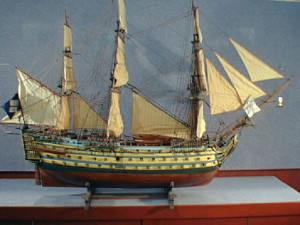The Ship
HMS Victory’s fame is due to the fact that she was the British flagship at the Battle of Trafalgar in August 1805. Built in 1765, she had had a remarkable service record under Admirals Keppel, Kempenfelt, Hower, Hood and Jervis. She also took part in battles of Ushant at Cape St. Vincent and was modernized several times. At that Battle of Trafalgar, while under the command of Admiral Nelson, Victory met Admiral de Villeneuve’s ships, Bucentaure and Redoutable.
“At one o’clock in the afternoon, Bucentaure presented her stern by sailing under the wind of Victory. Slowly passing by, Victory fired a 68-gun carronade broadside which mowed down everybody on Bucentaure’s decks and in its quarters, disabling 300 men. The wind being slack, Bucentaure could not disengage and had to suffer the salvos from the 50 guns on VICTORY’S port side, firing one after the other as the English ship was slowly passing her stern. The damage done was worse than if the English had fired at the ship’s side.” (Baron de Gaullard: Marine de Guerre a Voiles 1750-1850.)
The Battle of Trafalgar was the turning point in the Napoleonic Wars since it established England’s control of the seas, ultimately resulting in the loss of Napoleon’s sources of supply.
While the French defeat was decisive, Nelson, who conducted the battle at the side of Captain Hardy, was mortally wounded by a French Marine in the main-top of Redoutable.
Victory has served as a national shrine in its dry dock at Portsmouth, England, since 1825.
The Model
Scale: ¼” H 58” L 82” W 29”
1/8” H 34” L 53” W 24” (case)
Plank on frame construction by J. Stephen Murray

